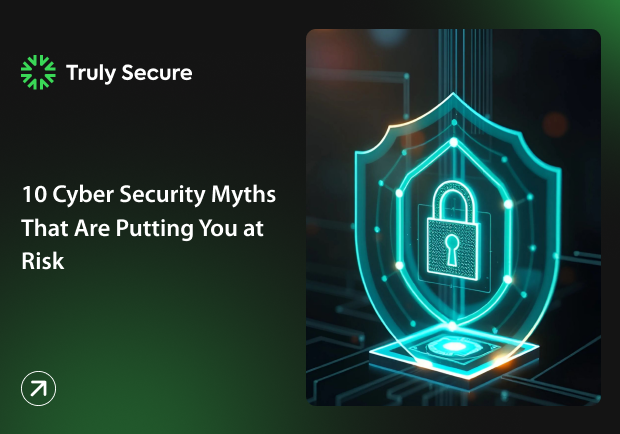In the world of cybersecurity myths and misconceptions can be dangerous. Some think group policies work on their own, while others believe cyberattacks won’t happen to them. These false ideas often lead to poor security. In this article, we’ll break down 10 common cybersecurity myths and share the right practices to stay safe.
Myth 1: Cybersecurity is Only for Large Companies
Many small and medium businesses believe hackers only target big corporations. In reality, cybercriminals often prefer smaller companies because they usually have weaker defenses.
Even if you’re running a web based app, an app website, or just exploring web app development, attackers can still exploit your vulnerabilities. It’s not about the size of your company; it’s about the value of the data you hold.
Right Practice:
Adopt baseline protections like firewalls, MFA, regular backups, and endpoint monitoring regardless of your company size. Even startups should integrate cybersecurity early.
Myth 2: Strong Passwords Alone Will Keep You Safe
While strong passwords are essential, they are not enough. Hackers now use advanced methods like phishing and credential stuffing to steal data.
Modern Cybersecurity best practices recommend multi-factor authentication (MFA), especially if you’re learning how to create a web app or manage user logins in a web design app. Without MFA, even the strongest password can be bypassed.
Right Practice:
Combine strong passwords with Multi-Factor Authentication (MFA) and use a password manager. Train employees to detect phishing attempts.
Myth 3: Antivirus Software is All You Need
Traditional antivirus programs protect against known threats, but cybercriminals constantly develop new, sophisticated attacks.
If your company is working on progressive web applications or learning how to make a progressive web app, antivirus alone won’t protect you. You need firewalls, intrusion detection systems, and continuous monitoring to stay safe.
Right Practice:
Adopt a layered defense: firewalls, intrusion detection/prevention systems, patch management, and 24/7 monitoring alongside antivirus.
Myth 4: Cybersecurity is an IT-Only Issue
One of the most common cybersecurity misconceptions is believing that only IT teams are responsible for data protection. In reality, every employee plays a role.
Whether you’re handling web design applications, understanding the difference between an app server and web server, or building apps for an Android web browser app, employees must understand cybersecurity awareness tips to prevent human errors.
Right Practice:
Conduct regular staff training on phishing, safe browsing, and data handling. Make cybersecurity everyone’s responsibility, not just IT’s.
Myth 5: Hackers Don’t Care About Individuals
People think only businesses are at risk, but hackers also target individuals. Personal devices, online accounts, and even your web design app projects can be compromised.
Knowing what a web app is and how personal data is stored in one helps individuals understand why cybercriminals can profit from stealing their personal information.
Right Practice:
Secure personal accounts with MFA, avoid oversharing online, use an updated antivirus on individual devices, and be cautious about public Wi-Fi.

Myth 6: Once Secure, Always Secure
Cybersecurity isn’t a one-time setup; it requires time. Threats evolve daily, and yesterday’s solutions may not work tomorrow.
For companies working on web app development, security must be built into every step. If you’re learning how to develop a web app, updating security patches and testing regularly are just as important as design and functionality.
Right Practice:
Schedule regular updates, patch vulnerabilities, and run penetration tests. Build security into every stage of web app development.
Myth 7: Cloud Services Automatically Mean Security
Storing data in the cloud is easy, but assuming cloud providers handle all security is a dangerous data protection myth.
When using a web based app or progressive web applications, companies must still configure security settings, manage permissions, and monitor activities. Cloud services give you the tools, but you’re responsible for using them correctly.
Right Practice:
Authorize encryption, configure access controls, apply least-privilege permissions, and monitor activity in the cloud environment.
Myth 8: Cybersecurity is Too Expensive
Most businesses think cybersecurity is too expensive. But the truth is: the cost of a breach is far greater.
If you invest in training, use secure coding for how to create a web app, and integrate checks into web design applications, you’re preventing expensive lawsuits, data loss, and reputational damage. In fact, adopting cybersecurity best practices for companies is more affordable in the long run.
Right Practice:
Start with affordable basics: staff training, backups, MFA, and patching. Use open-source security tools where possible and scale up gradually.
Myth 9: Hackers Only Use Complex Attacks
People believe hacking is always sophisticated, but often the simplest tricks like phishing emails, are the most effective.
For instance, a hacker might trick you into sharing credentials used in your app website or while testing an Android web browser app. Falling for these online security myths can make businesses underestimate simple, preventable risks.
Right Practice:
Apply email security filters, educate staff about phishing, and enforce password rotation policies. Simulate phishing attacks to test awareness.
Myth 10: Cybersecurity Tools Guarantee Safety
No single tool can make you 100% secure. Firewalls, antivirus, and encryption are powerful, but they must be combined with policies, training, and regular testing.
For developers focusing on web app development or trying to understand the difference between app server and web server, the lesson is clear: security is a process, not just a product.
Right Practice:
Combine technology, clear policies, regular audits, and ongoing employee training. Security is a process, not a product.
How Truly Secure Can Help You Stay Secure
At Truly Secure, we understand that Cybersecurity isn’t about tools it’s about strategies, and continuous monitoring. Whether you’re building progressive web applications, designing an app website, or learning how to develop a web app, we provide tailored solutions that secure your digital assets without slowing down innovation.
We help businesses:
- Build secure web based apps with compliance standards.
- Educate teams on cybersecurity awareness tips.
- Provide regular testing and monitoring for vulnerabilities.
- Integrate cybersecurity best practices for companies into daily operations.
- With our expertise, you don’t just adopt technology you adopt peace of mind.
FAQs
Q1: What is a web app in simple words?
A web app is software you use through a browser, like Gmail or Google Docs.
Q2: Are progressive web applications more secure?
Yes, if built with best practices, progressive web applications can be secure, but regular updates are still important.
Q3: Why is cybersecurity important for small businesses?
Because hackers often target them, knowing they may not have strong defenses.
Q4: Is antivirus enough for protection?
No, antivirus is helpful but you also need firewalls, updates, and awareness.
Q5: How can Prismatic Technologies help me?
We provide secure web app development, training, and ongoing monitoring to keep your business safe.


